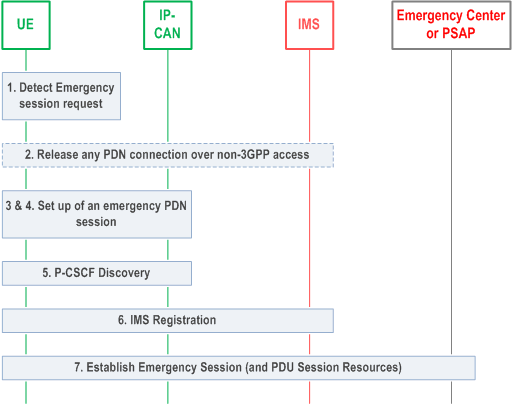Content for TS 23.167 Word version: 19.0.0
L IMS emergency services using non-3GPP access to 5GC
L.1 General
L.2 UE specific behaviour
L.3 High Level Procedures for IMS emergency calls
L.4 Location handling
...
...
L (Normative) IMS emergency services using non-3GPP access to 5GC |R15| p. 65
L.1 General p. 65
This annex includes additional clarifications when the IP-CAN corresponds to a non-3GPP access to 5GC.
Trusted and untrusted non-3GPP access to 5GC for emergency sessions are supported.
The UE may issue an Emergency session over non-3GPP access to 5GC only when 3GPP access for emergency call is not possible or available (e.g. no 3GPP coverage).
Further details on the procedures defined for non-3GPP access to 5GC support of support emergency sessions are defined in TS 23.502.
L.2 UE specific behaviour p. 65
Procedure for determining the list of emergency numbers:
- In addition to the emergency numbers and associated types stored either on the USIM or on the user equipment specified in clause 10.1.1 of TS 22.101, the UE shall use the stored Local Emergency Numbers List received from the 3GPP network to detect that the number dialled is an emergency number.
- If a UE has a SIM/USIM and has received a list of emergency numbers and associated types or URN information via mobility management procedures as described in TS 24.301 and TS 24.008 when connected to the PLMN using GERAN, UTRAN, E-UTRAN, or TS 24.501 when connected to NG-RAN or non-3GPP access connected to 5GC, or, for a UE supporting access to EPC via WLAN, as specified in Annex J, the UE shall use this list to determine if the dialled digits correspond to an emergency call as long as the UE has determined that the list is valid (see clause 4.1).
- The list of downloaded emergency numbers shall be deleted at country change or, if the particular list is only valid for a PLMN (see clause 10.4.1 of TS 22.101), at successful registration with a different PLMN.
- The UE shall establish an emergency PDU session over non-3GPP and shall perform an IMS emergency registration before sending an IMS emergency session request.
- The UE shall include any available location information in the IMS emergency session request. This is further detailed in TS 23.228.
- For the media supported during IMS emergency sessions, media codec and format support is specified in TS 26.114.
L.3 High Level Procedures for IMS emergency calls p. 66
For the high-level procedures (as described in clause 7.1.1) the following statements apply for UE detected emergency calls when 5GC access over non-3GPP access is used:
- the IP-CAN bearer resource is a PDU session dedicated for emergency services. TS 23.502 describes how to indicate that a PDU Session Request is for emergency.
- For registration requests received from an emergency PDU session, the P-CSCF shall reject any IMS registration which is not for the emergency purpose.
- The P-CSCF may reject the session initiation request with an indication that this is an emergency session or may allow the session initiation request to continue.

The following steps (numbering being the same as in Figure 7.1) are performed:
Step 1.
Same as step 1 of Figure 7.1.
Step 2.
In some exceptional cases (e.g. in congestion situation), the UE may release some PDU session it may have over non-3GPP access to 5GC.
Step 3.
Void (no "bearer registration" as described in step 3 of Figure 7.1).
Step 4.
As described in TS 23.502:
Step 5.
- in the case of untrusted access, the UE selects an N3IWF as for accessing regular services and sets-up a PDU session for emergency services;
- in the case of trusted access, the UE sets-up a PDU session for emergency services. The UE is assigned an IP address at this stage.
Same as step 5 of Figure 7.1.
Step 6.
Same as step 6 of Figure 7.1.
Step 7.
Same as step 7 of Figure 7.1, except that eCall is not supported via untrusted non-3GPP access.
L.4 Location handling p. 67
When a UE performs an emergency registration or initiates an IMS emergency session over untrusted non-3GPP access to EPC the UE provides location information that is further defined in TS 23.228.
For untrusted non-3GPP access to 5GC, provided location information can only correspond to the UE IP address seen by the N3IWF and used for traffic destined towards the UE.